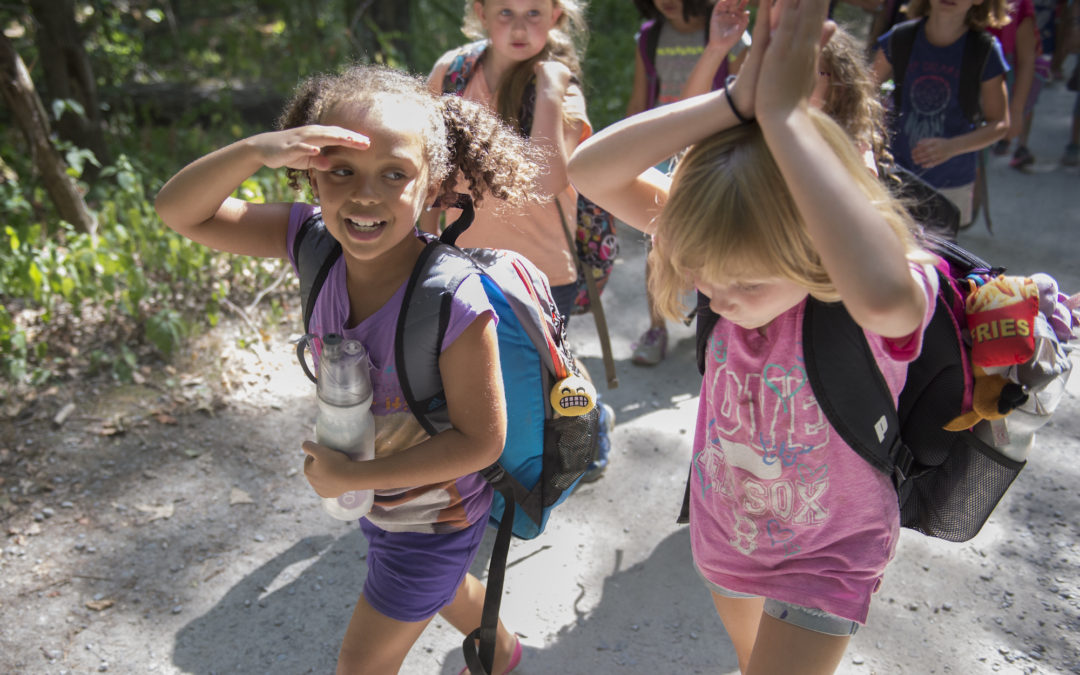Hello again! I’m back to share my 20+ years of camping experience to help you move through the steps of the Girl Scout Outdoor Progression Chart, because as you already know, I believe if a girl’s first outdoor experience is a positive one, she’ll be hooked for life. In my last blog, Meet Out, I addressed the second step in outdoor progression and getting outside with your girls. If you haven’t already, don’t forget to review Steps 1 and 2, LLook Out and Meet Out. If you have, then let’s go ahead and get started on Step 3: Move Out!
Pin this post for later!
GSUSA lists a few examples on the Outdoor Progression Chart of ways you and your girls might take the Move Out step together, like: Plan and take a short walk outside; Discuss being prepared for the weather; Do activities to explore nature; and Plan and carry out an indoor sleepover. These are all great options for moving out, but for this blog post, let’s take a short walk and explore some nature in our nearby neighborhoods. And yes, I said “walk,” because It’s important to walk before we hike. But don’t worry day hikes will come soon enough in Step 4: Explore Out, then longer hiking trips later on in the Outdoor Progression Chart.
Find a location for your walk
Sometimes the best location for your first walk is a place not far from your meeting spot—you’d be surprised what your local community has to offer. If you have trouble finding a good locations there are a few nice walking apps to use when researching possible walks for your group.
Do a pre-walk
Preview the walk before you lead your entire group to ensure you know the route. It is a good idea to do a practice walk, maybe just you and your family or you and your co-leaders, close to the actual walk date with your girls to make sure the path’s current condition is how you remember it. You want to be aware of changes to the sidewalk, road, and maintenance work or closures that might impact your route.
Select the appropriate number of adults to accompany the group on your walk then review the route so everyone understands. Provide maps if needed. Don’t forget to share your route as well as the start and expected end time with all families involved (those joining you as well as those dropping off and picking up).
Decide what to wear
Even though we all cross our fingers for perfect walking weather, I have learned the more you prepare for bad weather, the less “bad” it will feel if it happens. Be prepared for any weather and dress for active movement in the outdoors. There’s no need to buy anything—you will find everything you need in your own closet.
- Sturdy walking shoes or athletic shoes are fine for your first few walks. (In future blogs, I will address hiking boots for longer walks and rocky, uneven trails.)
- Loose-fitting, comfortable clothing. Dress in several light layers so that you can shed as your activity level increases or adapt to changes in weather.
- A hat to protect your face and head from sun and shield your eyes from the glare.
- 1 or 2 group backpacks to help carry trail maps, a group snack, insect repellent, sunscreen, and a first aid kit. You want to make sure your hands stay free in case you need to assist others.
- A water bottle. Depending on the length of you walk you may want to remind your girls to stay hydrated.
Pro Tip: Even on cloudy days, it is important in any outdoor activity to protect your skin and use sunscreen. If you hike is at dusk or near a wooded area, consider bringing insect repellent for protection against mosquitoes and other insects.
Organize the group
Always use the buddy system. Ask the girls to buddy up and look out for their buddy, then talk a bit about staying together and letting a group leader know if their buddy is having trouble. Split the adults up at the front, middle, and rear to help keep an eye on all the buddy groups.
Know the activity level of your girls, and let the group know where you are going or how long you expect to be hiking. It may be helpful to have girls with a slower stride lead from the front to avoid large gaps in the walk. You may even decide to split into two groups based on pace, distance, or number of chaperones.
Pro Tip: Plan for rest stops. When you pre-walk, scope out safe locations and public restroom facilities to take breaks along the way.
Setting expectations
Know when to call it quits. Plan for a few different stops and make this experience be about the walk, not the destination. By setting multiple landmarks, you know you can turn back if the group gets tired. This way every walk feels like a success, and your group can work up to the longer hike later.
Adults often find walking to a beautiful vista enough of a goal, because really, seeing the view from the vista is enough of a reward. This may not be the case with your girls, so try and add some games to the plan.
Play games
To avoid a forced march vibe, I like to add some fun games that help the group connect to the world around them. Here are some of my favorites:
- Follow the leader: You can do the traditional version or just switch up the buddy pair in the lead along the way, taking turns with who gets to hold the map and lead the group. You can also have your girls take turns carrying the group day pack or first aid kit.
- Guessing games like “I spy” or counting games are perfect for a group walk. Just saying, “Let’s see who can count the most birds from here to the next telephone pole!” is a great way to keep the group moving while still paying attention to the nature around them.
- Nature Bingo is a more challenging version of “I spy” that gives your girls specific items to look out for.
- A Color Hike will help your girls appreciate the abundance of natural colored items.
- If you group is really into animals, maybe pick up a couple of binoculars and stop to do some birdwatching along the way.
Don’t forget the debrief
Remember Moving Out is one of the first big steps outside, so make sure to leave some time at the end of your meeting to give your girls the chance to wrap-up and share all the cool things they learned. And like any accomplishment, it’s worth talking about!
Whether you decide to debrief during the walk or after, make sure everyone is comfortable. If possible, sit in a circle or find a nice picnic table and ask the girls how they think the walk went. If you have a group that’s a little more on the quiet side or they only respond with “it was ok”, “it was fun”, “it was boring”, or “I’m tired”, try to ask prompting questions like, “Does anyone want to share anything they saw, heard, or smelled along the way?”
Pro Tip: While you’re on the walk, keep an eye out for conversation starters. Cool things like, “Did you see that old fashion car?”, “Did you hear see that bird?”, “What do you think that smell was when we were walking buy that business?” or “Did you hear that dog barking? I wonder what they were barking at” might help get your girls talking.
Don’t be afraid to ask questions about the route—this will help you plan for next time. You could ask if they thought the walk was too long, just right, or not long enough. Get them excited for their next walk outdoors by asking them what they would bring if they were to go on a longer walk. Don’t forget to jot down any cool path recommendations that come up!
In next month’s blog post, I’ll talk about next step in Girl Scout Outdoor Progression Chart, Explore Out. Hopefully you found this information helpful and are now able to take the first step in getting your girls to move outdoors. Thank you for taking the time to step outside of your comfort zone and encouraging your girls to explore the world around them. If you have any great ways to Move Out or ideas for Explore Out, please share them in the comments section below—I’d love to hear them! Until next time, Happy Trails!
What to do next:
- The 2019 Camp Brochure is now available, find the program right for your girl on our camp website!
- Looking for related reads? Check out our other blog posts about getting outdoors with your Girl Scouts!
- From setting up a campsite to outdoor songs, GSUSA’s Outdoor Resources page has tons of helpful how-to videos.
- Have you been going through the Outdoor Progression Chart steps? Don’t forget to share your favorite outdoor activities and resources in the comments section below, and keep an eye out for my next blog post!
 Mary-Jane Strom—Mary-Jane is the Senior Director of Camps & Adventure at Girl Scouts of Northern California as well as a lifetime member of Girl Scouts, joining as a Brownie and completing her Gold Award in 1991. Mary-Jane fell in love with the outdoors and camping at a young age after her aunt sent her to Girl Scout camp as a birthday present. Mary-Jane has spent every birthday since at camp, returning summer after summer after summer. When not at camp, Mary-Jane enjoys a variety of other outdoor activities, like open water swimming and running.
Mary-Jane Strom—Mary-Jane is the Senior Director of Camps & Adventure at Girl Scouts of Northern California as well as a lifetime member of Girl Scouts, joining as a Brownie and completing her Gold Award in 1991. Mary-Jane fell in love with the outdoors and camping at a young age after her aunt sent her to Girl Scout camp as a birthday present. Mary-Jane has spent every birthday since at camp, returning summer after summer after summer. When not at camp, Mary-Jane enjoys a variety of other outdoor activities, like open water swimming and running.

